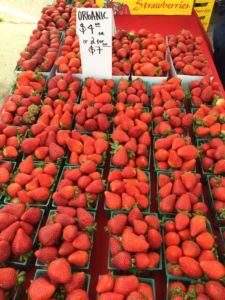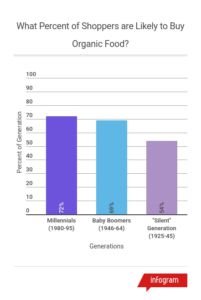Marin has been at the forefront of organic and sustainable food production for decades, ranking first as the healthiest county in the U.S for seven years straight, according to County Health Rankings. Marin values supplying organic, healthy food to the consumer spreads influence to other producers and counties nationwide. In 2015, according to the National Restaurant Association, 4 of the top ten trends related to local foods. The demand for locally grown and organic foods has given rise to the farm to table movement.
Farm to table restaurants obtain their ingredients directly from their partnered farms without going through a corporation or other supplier, according to the Culinary Director of Rustic Bakery, Nicolas Abrams. Buying local products ensures that these restaurants will avoid finding

genetically modified organisms (GMOs) in their products, as well as focusing on reducing the carbon footprint left behind with factory farms and mass food production.
Farm to table is a growing trend in society as more and more restaurants have begun partnering with local farms to produce fresh food daily. More than 87 percent of fine-dining establishments served locally sourced items nationwide in 2006, and since then that number has only increased, according to the U.S Department of Agriculture (USDA). According to Abrams, producing locally sourced and quality items are two of Rustic Bakery’s top priorities.
“For Rustic, our main purpose is to not have anything sitting around. We love having our product coming in fresh daily, prep it and go straight to the customers. We want it fresh off the field,” Abrams said.
Similar to Rustic Bakery, providing quality food is a priority for farm to table restaurants across Marin. Farmhouse Local, a farm to table restaurant in Larkspur, finds the most essential part of partnering with local farms is knowing exactly where their ingredients come from and who produces their food, according to chef and owner David Monson.
“Farm to table in general means trying to get as close to the actual producer of the food as possible,” Monson said. “The idea of farm to table is to short circuit the middleman and get to know the person who is actually growing your food.”
https://vimeo.com/220329249/1b4f53bca8Being personally connected to the farmers can ensure that food is being grown by a trusted partner, an important aspect for Monson and his restaurant.
“One person we know is our mushroom guy, and I only buy mushrooms through him. He can tell me I found these and they are really wet, or woody, or whatever the case may be because he picked them,” Monson said.
As Monson explained, many restaurants partner with large corporations, such as Sysco, a multimillion food distribution company. Sysco’s 400,000-plus item catalog conveniently sells everything a cook would need to run a restaurant. These meals require nothing more than the cook’s ability to heat, assemble and serve a dish.
Many of Sysco’s partners simply disregard the added phosphates, preservatives, sugar and additional components found in many of Sysco’s products, according to research by Slate Magazine. Farm to table restaurants aim at diverting from this process by retaining their ingredients directly from farms, in order to preserve the original, fresh taste.
“Fresh food is going to promote more food. Staying with that local flavor is always important,” Abrams said.
Farm to table restaurants have more benefits than meet the eye. According to the Federal Drug Administration (FDA), eating farm to table has proven to help prevent cancer, obesity, neurological, developmental and reproductive defects. These benefits are only a part of a long list of the reasoning behind the farm to table movement.
A group of researchers from Newcastle University found that organic foods were up to 69 percent higher in antioxidants

and lower in toxic metals and pesticides as compared to conventional foods. The leader of the study, Professor Carlo Leifert, has performed extra research on the benefits of antioxidants, linking antioxidants to a reduced risk of chronic diseases such as cardiovascular and neurodegenerative diseases.
Organic produce is the basis for farm to table restaurants, providing market incentives for farms around the US to produce larger ranges of products that include organic offerings. Between 2002 and 2007, producer to consumer sales of agriculture increased by 49 percent, according to the Department of Environment and Safety of Utah State University. The demand for organic based foods is widely acknowledged by farm to table restaurants.
“There is always an expectation of quality here. This county, certainly more than most, expects and wants organic. Luckily, organic is really plentiful here,” Monson said.
The demand for foods that are healthy, tasty and environmentally friendly are the principal drivers of organic food sales, inspiring producers, retailers and suppliers to meet this demand with organic alternatives to conventional food. The sales of organic products in 2015 increased by 72 percent from 2008, according to the U.S Department of Agriculture.
Providing quality organic ingredients can be a struggle for some farm to table restaurants. Organic food is still 47 percent more expensive than regular conventional goods, according to the Food and Agriculture Organization of the United Nations (FAO). Supplying and obtaining organic food can be more expensive because the organic food supply is limited as compared to its demand.
“It’s hard, because some customers don’t necessarily want the [freshness], they want the right price. It’s an important balance to reach out to all customers,” Abrams said.
Farm to table restaurants don’t only struggle with balancing their prices, but these restaurants can also encounter problems with supply.
“Supply is one of our biggest struggles. It can be hard to get the quality lettuce and the amount you need. As we get busier, we are having to order more and more, and some farms are unable to keep up with the demand,” Abrams said.
Placing heavy dependence on certain farms requires a mass production of certain products. Seasonal changes can also affect the rate of production for specific foods. Many farm to table restaurants often have to switch farms seasonally to keep up with the products offered during different seasons. According to Abrams, the winter does not provide as many popular crops as the summer.
“That’s why we try to be seasonal, to utilize the best product at the right time,” Abrams said.
Not only does farm to table require commitment from farms to exceed the ratio between supply and demand, but also requires the dedication from the staff. For Rustic Bakery, chefs and cooks have to be trained accordingly and being apart of the staff requires long working hours.
“Being a farm to table restaurant requires commitment from our staff. We are a bakery, so we have people starting at 2 am, and our prep people start at 5 am,” Abrams said.

The movement toward organic and locally grown produce can be most prominently recognized in younger generations, as standards of foods are shifting. According to a survey by the FDA, 72 percent of millennial shoppers buy or are likely to buy organic foods, while 69 percent of Baby Boomers would say the same.
Only 54 percent of older shoppers, or the “Silent Generation,” surveyed reported they would be interested in buying organic foods.
Farm to table restaurants are willing to risk the sacrifice of having less produce seasonally to continue providing fresh, locally grown ingredients to their customers, according to Monson. An extensive network of small artisan companies who produce top quality foods is present in Marin, and this network is only growing with the expansion of the farm to table movement and the interest in locally grown and organic food.
Monson shows interests in growing Farmhouse Local to reach out to a wider audience of customers beyond the Bay Area. If it is attainable economically, he hopes to have his own farm in Sonoma to provide organic and reasonably priced ingredients. Monson would like to inspire other restaurants to pursue the farm to table method that he worked hard to achieve with his business.
“We are always searching for the best ingredients. Our idea was let’s do breakfast, but let’s do great breakfast. Throw in some organic cream spinach, some cage free eggs and you have a whole different meal,” Monson said.














